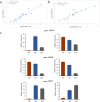Exploration of key genes and pathways in response to submergence stress in red clover (Trifolium pratense L.) by WGCNA
- PMID: 39748309
- PMCID: PMC11697040
- DOI: 10.1186/s12870-024-05804-z
Exploration of key genes and pathways in response to submergence stress in red clover (Trifolium pratense L.) by WGCNA
Abstract
Background: Submergence stress is a prevalent abiotic stress affecting plant growth and development and can restrict plant cultivation in areas prone to flooding. Research on plant submergence stress tolerance has been essential in managing plant production under excessive rainfall. Red clover (Trifolium pratense L.), a high-quality legume forage, exhibits low tolerance to submergence, and long-term submergence can lead to root rot and death.
Results: This study assessed the microstructure, physiological indicators, and the key genes and metabolic pathways under submergence stress in the root system of red clover HL(Hong Long) and ZY(Zi You) varieties under submergence stress at 0 h, 8 h, 24 h, 3 d, and 5 d. Based on 7740 transcripts identified in the leaves at 0 h, 8 h, and 24 h submergence stress, Weighted Gene Co-expression Network Analysis (WGCNA) was performed on the differentially expressed genes (DEGs) at 8 h and 24 h. Functional annotation of the DEGs in the four key modules was obtained. Based on the results, the red clover root system exhibited epidermal cell rupture, enlargement and rupture of cortical thin-walled cells, thickening of the mid-column, and a significant increase in the number of air cavities and air cavity area of aeration tissue with the prolongation of submergence stress. The malondialdehyde content, relative conductivity, peroxidase, and superoxide dismutase initially increased and decreased as submergence stress duration increased. Four specific modules (cyan, purple, light cyan, and ivory) closely correlated with each stress were identified by WGCNA. The 14 obtained Hub genes were functionally annotated, among which six genes, including gene51878, gene11315, and gene11848, were involved in glyoxylate and dicarboxylic acid metabolism, carbon fixation in photosynthetic organisms, carbon metabolism, biosynthesis of pantothenic acid and CoA, flavonoid biosynthesis.
Conclusion: In this study, using WGCNA, the molecular response mechanisms of red clover to submergence stress was proposed, and the core genes and metabolic pathways in response to submergence stress were obtained, providing a valuable data resource at the physiological and molecular levels for subsequent studies of submergence stress tolerance in plants.
Keywords: Microstructure; Morphological structure; Physiological index; Submergence stress; Trifolium pratense; WGCNA.
© 2024. The Author(s).
Conflict of interest statement
Declarations. Ethics approval and consent to participate: We all declare that manuscript reporting studies do not involve any human. participants, human data, or human tissue. So, it is not applicable. Consent for publication: Not applicable. Competing interests: The authors declare no competing interests.
Figures







Similar articles
-
Unveiling the Complexity of Red Clover (Trifolium pratense L.) Transcriptome and Transcriptional Regulation of Isoflavonoid Biosynthesis Using Integrated Long- and Short-Read RNAseq.Int J Mol Sci. 2021 Nov 23;22(23):12625. doi: 10.3390/ijms222312625. Int J Mol Sci. 2021. PMID: 34884432 Free PMC article.
-
Physiological, biochemical, and transcriptional regulation in a leguminous forage Trifolium pratense L. responding to silver ions.Plant Physiol Biochem. 2021 May;162:531-546. doi: 10.1016/j.plaphy.2021.02.046. Epub 2021 Mar 11. Plant Physiol Biochem. 2021. PMID: 33773229
-
De novo assembly of red clover transcriptome based on RNA-Seq data provides insight into drought response, gene discovery and marker identification.BMC Genomics. 2014 Jun 9;15(1):453. doi: 10.1186/1471-2164-15-453. BMC Genomics. 2014. PMID: 24912738 Free PMC article.
-
Flooding tolerance of forage legumes.J Exp Bot. 2017 Apr 1;68(8):1851-1872. doi: 10.1093/jxb/erw239. J Exp Bot. 2017. PMID: 27325893 Review.
-
Survival mechanisms of plants under hypoxic stress: Physiological acclimation and molecular regulation.J Integr Plant Biol. 2025 Mar;67(3):440-454. doi: 10.1111/jipb.13880. Epub 2025 Mar 7. J Integr Plant Biol. 2025. PMID: 40052431 Review.
Cited by
-
Comparative Proteome and Weighted Gene Co-Expression Network Analyses Uncover the Mechanism of Wheat Grain Protein Accumulation in Response to Nitrogen Fertilizer Application.Foods. 2025 Apr 24;14(9):1481. doi: 10.3390/foods14091481. Foods. 2025. PMID: 40361565 Free PMC article.
-
Weighted Gene Co-Expression Network Analysis Uncovers Core Drought Responsive Genes in Pecan (Carya illinoinensis).Plants (Basel). 2025 Mar 7;14(6):833. doi: 10.3390/plants14060833. Plants (Basel). 2025. PMID: 40265729 Free PMC article.
References
-
- Striker GG, Colmer TD. Flooding tolerance of forage legumes. J Exp Bot. 2017;68(8):1851–72. - PubMed
-
- Song M, Li X, Saikkonen K, Li C, Nan Z. An asexual Epichloe endophyte enhances waterlogging tolerance of Hordeum brevisubulatum. Fungal Ecol. 2015;13:44–52.
-
- Mustroph A, Albrecht G. Tolerance of crop plants to oxygen deficiency stress: fermentative activity and photosynthetic capacity of entire seedlings under hypoxia and anoxia. Physiol Plant. 2003;117(4):508–20. - PubMed
MeSH terms
LinkOut - more resources
Full Text Sources

